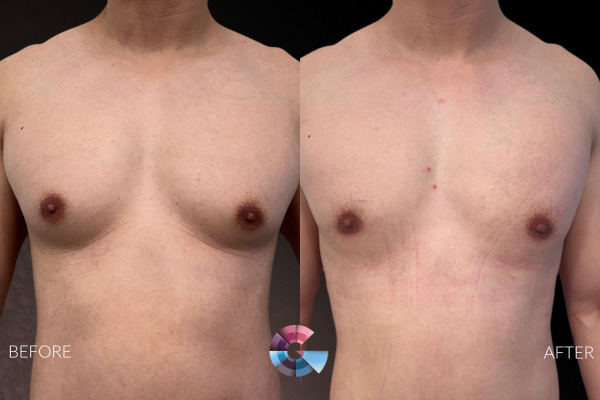
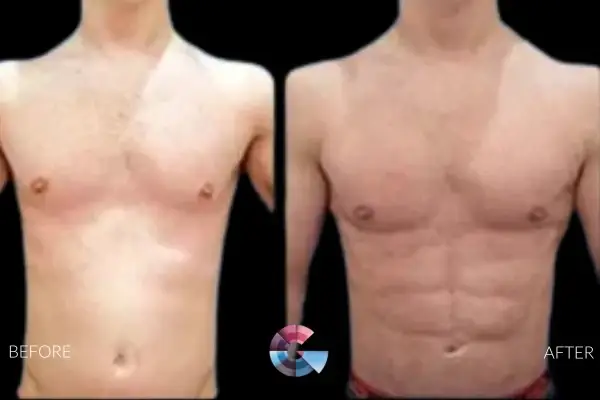
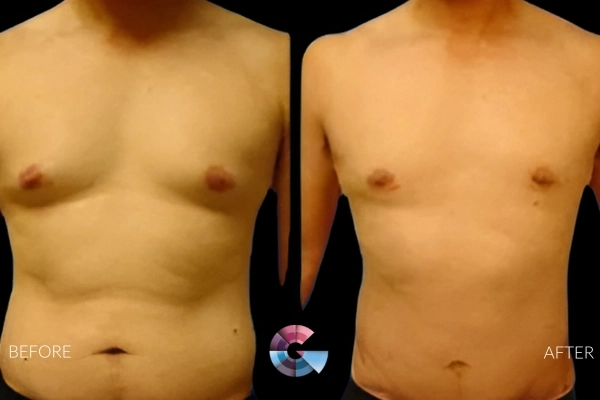
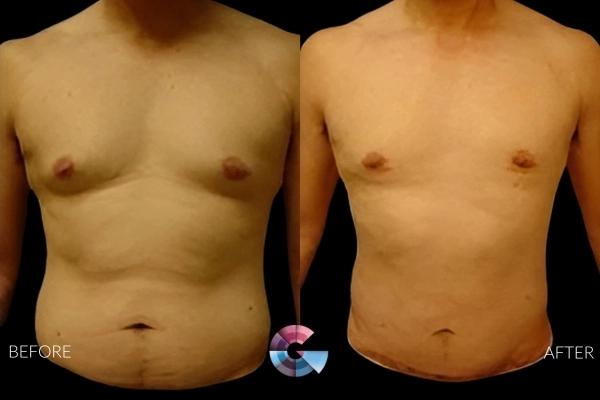
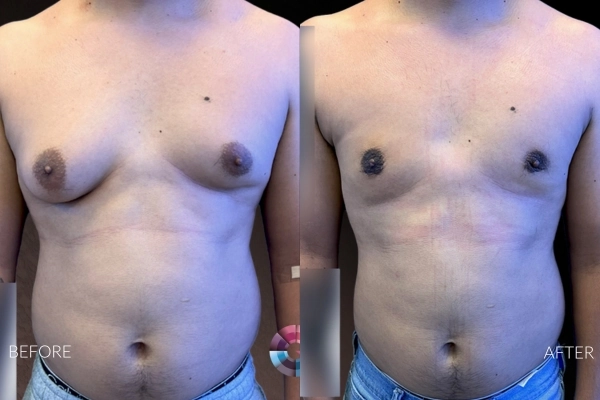
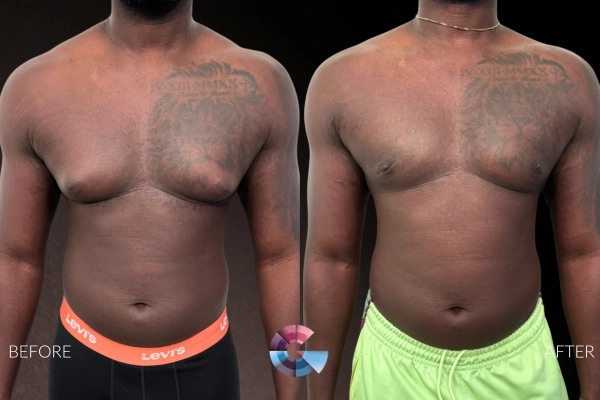
Have you ever looked in the mirror and wished for a different reflection? It’s an all too common experience for men dealing with male breast reduction before and after. The journey to regain their confidence can feel like navigating through a maze. But what if there was light at the end of that labyrinth?
You’re not alone; many have walked this path before. From understanding male breast reduction surgery, preparing for it, and learning about the procedure itself – each step brings its own questions.
In our journey together here, we’ll explore real-life examples from patients who underwent successful surgeries. You’ll get insights into post-operative care and long-term outcomes so you know exactly what to expect while regaining your masculine chest.
Are you ready to begin this transformative journey of Male Breast Reduction Before and After?
Table of Contents:
- Understanding Male Breast Reduction Surgery
- The Male Breast Reduction Procedure
- Preparing for Male Breast Reduction Surgery
- Recovery and Post-Operative Care
- Results and Expectations After Male Breast Reduction
- Case Studies and Patient Testimonials
- Choosing the Right Surgeon for Male Breast Reduction
- FAQs in Relation to Male Breast Reduction Before and After
- Conclusion
Understanding Male Breast Reduction Surgery
Gynecomastia, a condition resulting in enlarged breasts in men, can affect anyone from bodybuilders to college students. It’s more than just an aesthetic concern—it often leads to discomfort and self-esteem issues. But there’s good news: male breast reduction surgery is here to help.
Defining Gynecomastia
Gynecomastia, colloquially known as ‘man boobs,’ occurs when glandular tissue expands, causing male breasts to swell. This isn’t due solely to excess fat—though it may play a role—but also the growth of actual breast tissue. Some cases even lead to puffy nipples, which might make you feel uncomfortable or less masculine.
This condition varies greatly among individuals—a textbook case for one patient could look vastly different for another. Bodybuilder gynecomastia type 1 patients typically have very little fatty tissue but prominent glandular enlargement around the nipple area. In contrast, other types involve varying amounts of glandular and fatty tissues across the chest region.
Identifying the Causes and Symptoms
The exact cause of gynecomastia remains unknown in many instances; however, hormonal imbalances are often at play—with estrogen (female hormones) levels being too high relative to androgens (male hormones). Other causes include certain medications, health conditions like liver disease or tumors, alcohol use disorder, or aging.
Symptoms generally involve swelling of your chest area that may be tender or painful on touch—an experience shared by our breast reduction patient, John Doe, who underwent correction after years of feeling uncomfortable with his persistent fullness despite a regular exercise regimen.
An Array Of Procedures
Different techniques could be employed to care for gynecomastia, depending on the cause and gravity. From direct excision of glandular tissue to liposuction for fatty tissue removal—each procedure is tailored to your unique case.
But you will leave with a renewed sense of self. At Gynecomastia LA, we’re more than just surgeons; we’re your partners in gaining back confidence and embracing your body anew.
The Male Breast Reduction Procedure
Getting rid of man boobs can be a game-changer for many men. Not just the outside but also what’s inside matters when eliminating man boobs. Let’s take a closer look at what goes on during male breast reduction surgery.
Understanding Anesthesia Options
Your comfort is paramount, so we start by numbing the chest area with anesthesia. The choice between local and general anesthesia will depend on your overall health and the extent of gynecomastia. (#)
Local anesthesia allows you to stay awake without feeling pain, while general puts you completely under. (#) Rest assured, our team will help make this decision as smooth as possible.
Exploring Surgical Techniques
We have several tools in our arsenal for getting that masculine chest back into shape – namely direct excision and liposuction. (#)
In cases where there is excess glandular tissue causing puffy nipples or enlarged breasts, direct excision works best. This technique involves making an incision around the areola (nipple region) and removing unwanted tissue directly.
- Liposuction: becomes the go-to method if fatty tissue buildup is more pronounced than glandular enlargement. (Think less Hulk Hogan mid-match sweat-fest; more reclining poolside sipping margaritas.) A small cannula removes fat via suction through tiny incisions made in inconspicuous areas on your chest.
The beauty here lies in combining both techniques if necessary. No matter what you need, we have a solution for you. (#)
While the procedure typically lasts 1-3 hours, remember that it’s just a fraction of your journey towards reclaiming confidence and self-esteem. But hey, Rome wasn’t built in a day.
Preparing for Male Breast Reduction Surgery
Before beginning your journey with male breast reduction surgery, ensure you are fully prepared. Knowing what steps are involved will help set your mind at ease.
Your First Step: Consultation With a Cosmetic Surgeon
First off, meeting with an experienced surgeon is crucial. To get the most out of your consultation, a cosmetic surgeon can provide comprehensive information and address any queries.
You’ll also undergo medical evaluations and tests during this time. The goal here is to ensure that you’re in good health for the procedure and to understand the specific type of gynecomastia affecting you – whether it’s fatty tissue accumulation or excess glandular tissue presence.

The Pre-Operative Phase: Making Lifestyle Changes
Prior to undergoing male breast reduction surgery, some lifestyle changes might be needed depending on your unique case. Your physician could suggest alterations like adopting healthier eating habits or reducing alcohol consumption as part of pre-operative instructions.
- Body Builder Gynecomastia Type 1, an interesting read detailing how bodybuilders manage their puffy nipples before surgery, shows that no one size fits all when dealing with gynecomastia cases.
- A study found varied experiences from patients who underwent similar procedures. Each individual has his own story and the road towards achieving a more masculine chest region free from persistent fullness caused by enlarged breasts.
Setting Expectations Right:
An important aspect of preparation involves setting correct expectations about recovery time post-surgery and potential outcomes. You should discuss these details thoroughly with your surgeon before undertaking any procedure(s).
Preparing for a male breast reduction procedure may be intimidating, but it can become much simpler with the correct direction and data. Remember to keep an open line of communication with your surgeon throughout this journey – you’re not alone in this.
Recovery and Post-Operative Care
After your male breast reduction surgery, following post-operative care instructions is vital. This can help manage pain and discomfort after the procedure.
Post-Surgery Pain Management
The first step in managing post-surgery discomfort is understanding what you might experience. Immediately following the operation, some chest fullness or tightness is normal due to swelling.
Your surgeon will prescribe medication that should alleviate most of the pain. However, if intense discomfort persists despite medication use, don’t hesitate to ask your surgical team for advice.
Besides medications, ice packs can relieve soreness and gently reduce inflammation. Just ensure not to apply them directly onto the skin; wrap them in a thin cloth instead.
Dressings and Drains
To assist with healing and prevent fluid build-up around the operated area – a common occurrence – surgeons often place drains during surgery which are removed within several days post-op. The drain site needs cleaning daily using mild soap, followed by an antibiotic ointment as advised by your surgeon’s office staff.
Bandages applied immediately after surgery offer additional support besides protecting incision sites against infection. Change these dressings regularly according to the guidance, but ensure they remain dry until removal is scheduled, usually within 7-10 days following the procedure date, depending on individual patient recovery progress.
Any signs such as increased redness or drainage must be reported promptly since this could indicate potential complications requiring immediate attention.
Compression Garments: An Essential Aid For Recovery
A crucial part of gynecomastia surgery recovery involves wearing compression garments over operated areas. This helps minimize swelling while offering support and encouraging skin retraction and contouring. The garment must be worn constantly for the first few weeks post-op, then during daytime hours only for several more weeks.
Compression garments can also provide some comfort by reducing the movement of surgical sites, especially when returning to regular activities.
Lastly, don’t forget that patience plays a crucial role. Achieving full recovery after gynecomastia takes time.
Results and Expectations After Male Breast Reduction
Anxiety and anticipation may be experienced when considering male breast reduction; however, what could one expect after the procedure? But don’t fret. Let’s explore what you might expect after your gynecomastia surgery.
Early Post-Operative Changes in The Chest Area
The chest area will show some immediate changes post-surgery. You’ll notice a flatter, firmer chest contour almost right away as excess glandular tissue is removed. However, keep in mind that everyone’s body responds differently to surgery – patience is key.
A study, for example, showcases various types of gynecomastia cases where early post-operative changes were visible from patients with puffy nipples to bodybuilders (Research 1).
Navigating Residual Swelling and Bruising
You may experience some residual swelling and bruising initially, but this should reduce over time as the body heals naturally.
Your surgeon might recommend wearing a compression garment during recovery time, which helps manage swelling while supporting new chest contours.
Nipple Sensitivity Post-Surgery
Sensitivity or numbness around the nipple area is not uncommon following male breast reduction procedures. Most men report these sensations easing up within a few weeks or months after their procedure(s).
Caring for Scars: A Key Part Of Recovery
Are you fretting about scarring? Here’s something uplifting: proper care makes them fade faster than expected. Your surgeon will guide you on scar management techniques, including massage exercises and topical creams encouraging healing.
- Please consult your primary care physician before starting any treatment regimen post-surgery.
The Final Result: A More Masculine Chest
Imagine this – you’re standing in front of a mirror, looking at your new, more masculine chest. That’s the end goal. Your final results will become apparent once the swelling has completely subsided and the incision lines have faded. This could take several months but remember, good things come to those who wait.
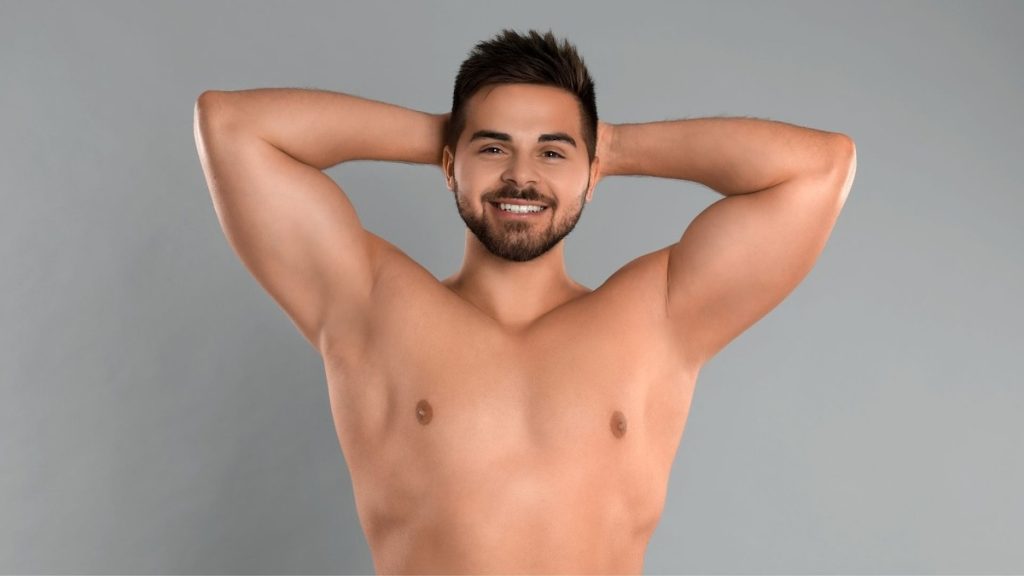
Case Studies and Patient Testimonials
The proof of any procedure’s success is in the results. Let’s examine a few actual cases.
A 20-year-old college student: This young man was dealing with enlarged breasts, commonly known as ‘man boobs.’ He felt uncomfortable removing his shirt in public or participating in activities that would highlight his chest area. After deciding to get male breast reduction surgery, he experienced significant improvement in self-esteem. The excess glandular tissue causing the persistent fullness was removed during the gynecomastia procedure, leading to a more masculine chest appearance.
A 30-year-old bodybuilder: Even though our patient here worked hard for his physique, he still had puffy nipples – a textbook case of nipple gynecomastia caused by residual glandular tissue under the areola complex that didn’t respond well to exercise or dieting.
This kind of situation often happens among men who lose weight but can’t seem to get rid of their male breasts entirely because it’s not just fatty tissue – it’s also excess breast tissue that needs surgical intervention for complete resolution. After undergoing correction through Type 4 Gynecomastia gland removal and liposuction, there was an impressive transformation.
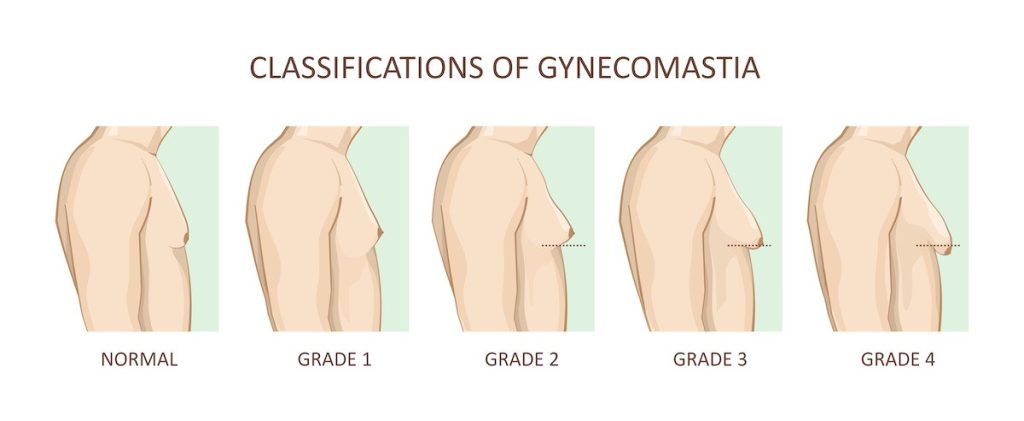
Choosing the Right Surgeon for Male Breast Reduction
Selecting an experienced cosmetic surgeon for your male breast reduction surgery is crucial. The expertise of a skilled surgeon not only guarantees better results but also minimizes risks and ensures a smoother recovery.
Credentials Matter
A qualified surgeon should have extensive experience in performing male breast reduction surgeries. These procedures require specialized skills to remove excess glandular tissue effectively, reshape the chest region, and deliver a more masculine contour. So, make sure your chosen professional can demonstrate this level of competency.
But how do you evaluate these qualifications? Here are some pointers:
- Verify if they’re approved by esteemed organizations, for example, the American Board of Cosmetic Surgery (ABCS), to ascertain their qualifications. This certification shows that they’ve undergone rigorous training and meet high standards in patient safety and ethics.
- Evaluate their surgical portfolio. Many surgeons maintain a photo gallery showcasing before-and-after pictures from previous patients. Look specifically at cases similar to yours – such as those with puffy nipples or enlarged breasts due to gynecomastia – so you get an idea about potential outcomes.
- Inquire about their approach towards gynecomastia removal methods like direct excision or liposuction. Your body type, degree of gynecomastia, skin elasticity, etc., will determine which technique suits you best – indicating that customization plays key role here.
The importance of selecting someone specializing in male breast reduction cannot be overstated; it’s akin to picking up the perfect pair of sneakers among myriad choices: one size doesn’t fit all. You want expert hands crafting your new look—so don’t settle until you find them.
Beyond credentials, though, remember—it’s important that you feel comfortable with your surgeon. They should address your worries, answer queries honestly, and recognize your decision-making procedure. After all, it’s not just about the surgery but also the recovery journey afterward.
Lastly, ensure you understand what’s included in their service: pre-op consultations. Post-surgery follow-ups? Do they have resources available for support during the recovery time?
Key Takeaway: Choosing a skilled cosmetic surgeon for male breast reduction surgery is vital. Look for board certification, experience with similar cases, and their approach to different gynecomastia removal methods. Don’t forget the importance of feeling comfortable with your chosen professional—this includes being listened to and respected in your decision-making process. Lastly, make sure you understand what’s included in their service package; this could range from pre-surgery consultations to post-operative care.
FAQs About Male Breast Reduction Before and After
Is male breast reduction worth it?
Yes, many men find relief and boosted self-esteem after surgery. The procedure can help restore body proportions and eliminate discomfort caused by gynecomastia.
How painful is male breast reduction surgery?
Pain varies from person to person but modern anesthesia techniques make the process tolerable. Post-surgery discomfort is managed with prescribed painkillers.
Can male breasts be reduced without surgery?
In some cases, weight loss or hormone treatments may help. But for true gynecomastia, surgical intervention is often necessary for complete resolution.
Does insurance cover gynecomastia?
This depends on your policy specifics. Some insurers might cover if it’s deemed medically necessary due to physical symptoms like pain or tenderness.
Conclusion
Transforming your life through male breast reduction before and after is no small feat. It takes courage, understanding, and preparation.
You’ve learned about gynecomastia – its causes, symptoms, types of procedures available. You’ve discovered how to prepare for the surgery with consultations, medical evaluations and lifestyle changes.
We dove deep into the procedure itself; from anesthesia options to surgical techniques like glandular tissue removal and liposuction. And let’s not forget post-operative care instructions along with recovery expectations.
You now know what changes to expect in the chest area post-surgery including residual swelling and bruising. Plus you have real-life examples of successful surgeries which offer hope on this journey towards a more masculine chest!
This transformative journey may seem daunting but remember: countless others have navigated it successfully too!

Dr.Babak Moeinolmolki
LA Cosmetic Surgeon Dr. Moein is board-certified by the American Board of General Surgery.
